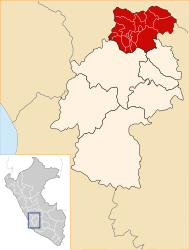Salcabamba District
| Salcabamba District | |
|---|---|
 The Salcabamba district is located in the central north of the Tayacaja Province (marked in red) |
|
| Basic data | |
| Country | Peru |
| region | Huancavelica |
| province | Tayacaja |
| Seat | Salcabamba |
| surface | 192.5 km² |
| Residents | 3828 (2017) |
| density | 20 inhabitants per km² |
| ISO 3166-2 | PE-HUV |
| Website | munisalcabamba.gob.pe (Spanish) |
| politics | |
| Alcalde District | Yurian Yllesca Díaz (2019-2022) |
| Political party | Movimiento Independiente Trabajando para Todos |
Coordinates: 12 ° 12 ′ S , 74 ° 47 ′ W
The Salcabamba district is located in the Tayacaja province of the Huancavelica region in central Peru . The district has an area of 192.52 km². At the 2017 census, 3828 inhabitants lived in the district. In 1993 the population was 5765, in 2007 it was 5121. The district administration is located in the village of Salcabamba at an altitude of 3037 m with 247 inhabitants (as of 2017). Salcabamba is located about 23 km north-northeast of the provincial capital Pampas and almost 50 km east-southeast of the city of Huancayo . Most of the population is of indigenous origin with Quechua as their mother tongue .
Geographical location
The Salcabamba district is located in the Peruvian Central Cordillera in the central north of the Tayacaja Province. The lower reaches of the Río Mantaro flows north along the eastern district boundary. The Río Salcabamba, a tributary of the Río Mantaro, flows through the district in a southerly direction.
The Salcabamba district borders in the southwest with the district Huaribamba , in the northwest with the district San Marcos de Rocchac , in the northeast with the district Salcahuasi , in the east with the district Surcubamba and in the south with the districts Quishuar and Daniel Hernández .
Individual evidence
- ↑ a b Peru: Huancavelica - Provinces & Districts . www.citypopulation.de. Retrieved February 20, 2020.